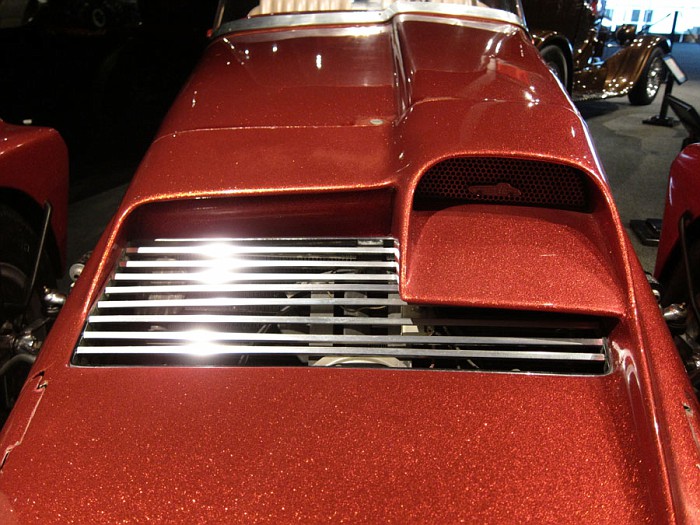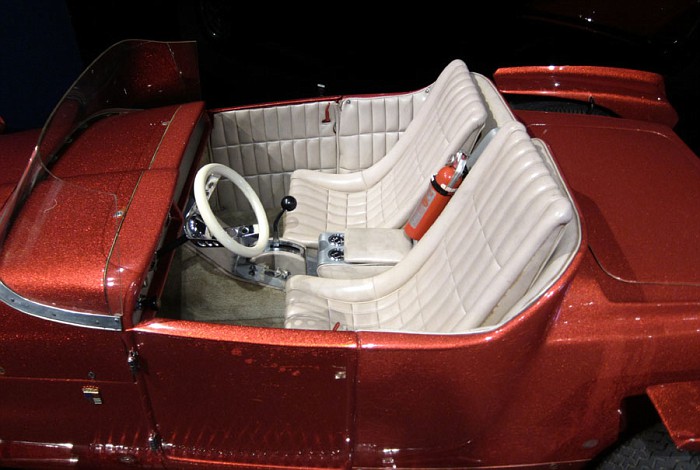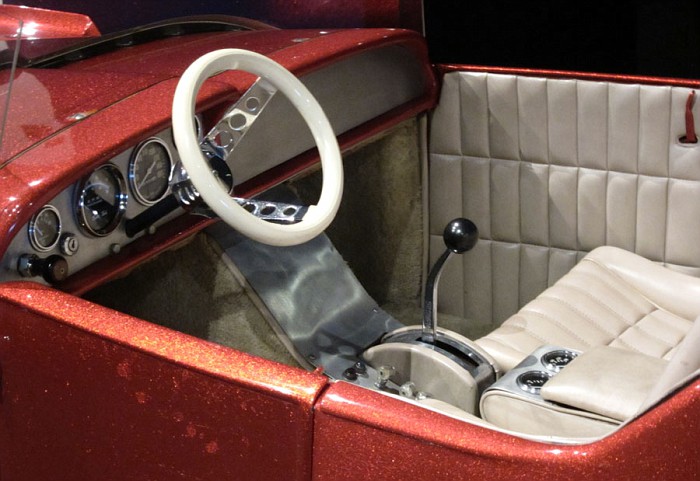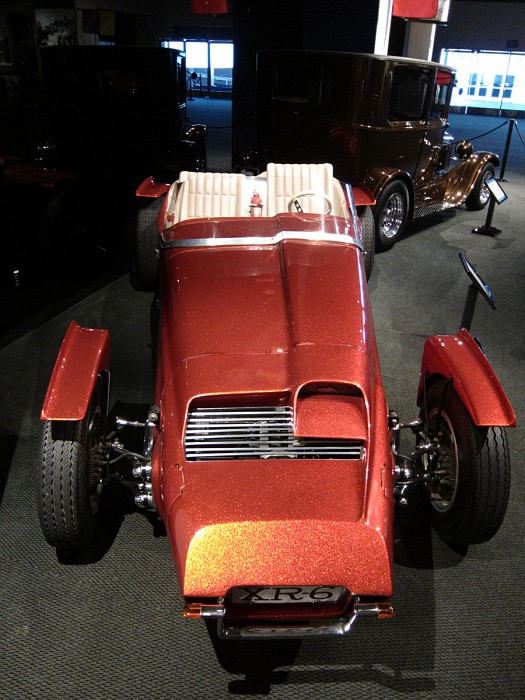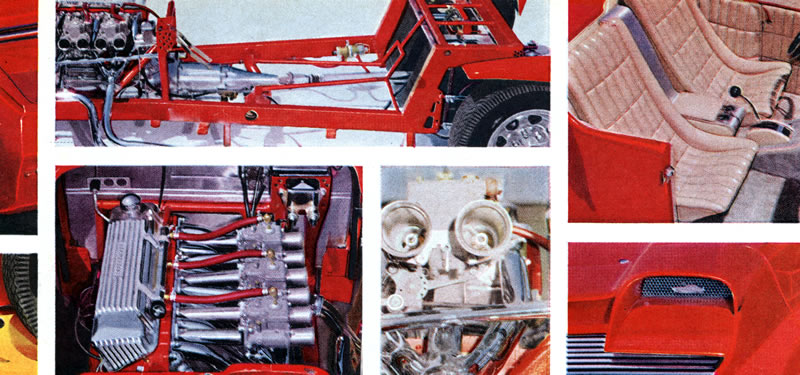Tex Smith’s Hot Rod XR-6
 Tex Smith’s Hot Rod XR-6
Tex Smith’s Hot Rod XR-6
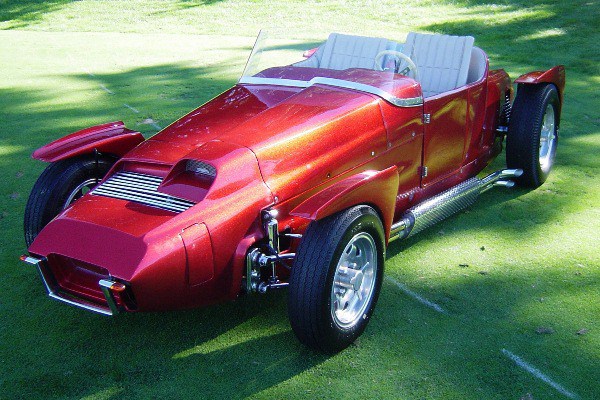
It’s hard to know exactly what to make of the XR6 today. Built in 1962-63 by LeRoi Tex Smith, then an associate editor at Hot Rod Magazine (MCG’s former stomping ground), the car is clearly a product of its time—as exemplified by the Jetsons fenders, hideaway headlamps, and far-out asymmetric styling theme.
The XR6 made a big splash when it was new, winning the America’s Most Beautiful Roadster award at the Grand National Roadster Show in 1963 and generating an AMT model kit. But the car’s cutting-edge early ’60s look also dated it, and the XR6 quickly sank from view as street rodding headed off in another direction, embracing traditionalism with both arms.
But today, we can look back on the XR6 and view it for what it is: one moment in time. And on that basis we can dig the XR6 for what it is, and for the brief period in rodding it so ably represents. Thankfully, the car was never updated to reflect passing fads and trends over the years. It’s true to its origin, and from that angle it has help up well.

Designed by George, finished in 1962, the XR-6 was to investigate the uses of modern ideas in Hot Rod design. It won the "America’s Most Beautiful Hot Rod". Made from the metal body from the model T Ford. The floor plan was removed and the body cut lengthwise then widened five inches. The rear section was hand formed in steel then grafted to the original back panel. All four fenders were sculptured from sheet stock and matching the Firestone tires and Crager wheels. Tony Nancy crafted all the interior from natural pure USA hyde leather. Gene Winfield constructed the aluminum hood, side panels and Gordon Vann fitted the full belly pan. Auto Electric did all the wiring, while the six cylinder engine was installed with multiple Weber carbs. A Hurst shifter was attached to the Torque Flight transmission with Stewart Warners gages. 40 coats of Kandy Tangerine were applied.
http://www.barris.com/carsgallery/kustomshotrods/xr6.php
Dernière édition par Predicta le Ven 8 Oct - 22:57, édité 1 fois
_________________
We don't care the People Says , Rock 'n' roll is here to stay - Danny & the Juniors - 1958
 The XR-6 - The Concept That Started it All
The XR-6 - The Concept That Started it All
When I got out of the air force as a jet jock, Wally Parks asked me to join the staff of Hot Rod magazine. I had been involved with the NHRA from the beginning, so he knew all of my weaknesses. This was in 1957, and the Petersen Publishing offices were at 5959 Hollywood Blvd., in their second ever building (which was an old market with upstairs mezzanine offices). The entire staff at that time was Parks as editor, Bob Greene as managing editor, Ray Brock the technical guru, Eric Rickman the cameraman, and three secretaries. Twice a day, or on any pretext, most of us would convene in Greene’s glass fronted office to ogle the girls on Hollywood Blvd. and talk magazine business. It was during one of these meetings that the conversation turned to traditional rodding. Since I had a strong background in this area, I normally handled all the magazine material that related to what would eventually become “street rods.”

In 196l, the talk went something like, “You know, all the really neat stuff coming out of Detroit is only going to get better. The old-style hot rods are fast disappearing because you can go to a local dealer and drop a small down for a brand-new car that will kick the butt of any of the old hot rods…” This theory was ever so true, and would get even stronger, as history has proven. “You’re right,” I countered, “but they just don’t have the character of a roadster or coupe. That’s why Dick Scritchfield started the L.A. Roadsters car club. Even so, I think it is possible to take an old body style, combine the basic line with some styling updates, and add a few modern power/suspension things to have a very contemporary looking and handling machine.” Whereupon Bob Greene said it would make an interesting Hot Rod article. This is when I started noodling the idea.
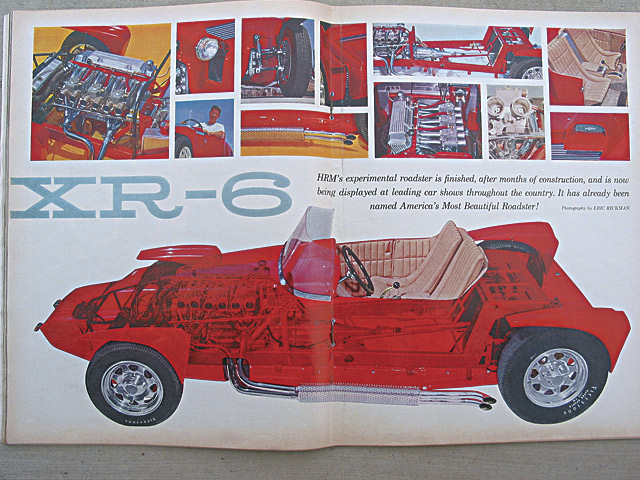
I already owned an engine/transmission combination that I thought was both unusual and powerful enough for a good street driven rod. It was in the form of an aluminum truck block limited production Dodge Slant 6 with an automatic trans (it was out of a factory test car that I had bought from Chrysler). It had run hard in the station wagon, with a long ram induction and split exhaust, officially listed as a Hyper-Pak option. But, in those days it was common for the factories to push the envelope with their “magazine test” prepared cars; this engine/trans/rearend combination was a dynamite package that was far better than what I wanted in my family wagon. The West Coast PR rep for Chrysler had the original power package put back in the wagon, and gave me the other stuff.


In 196l, the talk went something like, “You know, all the really neat stuff coming out of Detroit is only going to get better. The old-style hot rods are fast disappearing because you can go to a local dealer and drop a small down for a brand-new car that will kick the butt of any of the old hot rods…” This theory was ever so true, and would get even stronger, as history has proven. “You’re right,” I countered, “but they just don’t have the character of a roadster or coupe. That’s why Dick Scritchfield started the L.A. Roadsters car club. Even so, I think it is possible to take an old body style, combine the basic line with some styling updates, and add a few modern power/suspension things to have a very contemporary looking and handling machine.” Whereupon Bob Greene said it would make an interesting Hot Rod article. This is when I started noodling the idea.

I already owned an engine/transmission combination that I thought was both unusual and powerful enough for a good street driven rod. It was in the form of an aluminum truck block limited production Dodge Slant 6 with an automatic trans (it was out of a factory test car that I had bought from Chrysler). It had run hard in the station wagon, with a long ram induction and split exhaust, officially listed as a Hyper-Pak option. But, in those days it was common for the factories to push the envelope with their “magazine test” prepared cars; this engine/trans/rearend combination was a dynamite package that was far better than what I wanted in my family wagon. The West Coast PR rep for Chrysler had the original power package put back in the wagon, and gave me the other stuff.

_________________
We don't care the People Says , Rock 'n' roll is here to stay - Danny & the Juniors - 1958
 Re: Tex Smith’s Hot Rod XR-6
Re: Tex Smith’s Hot Rod XR-6
With nothing more than a hacksaw, gas welder, and small Lincoln arc welder in my home garage, I made up a 2×4 mild steel frame in a simple ladder design. To the front I grafted a twin trailing torsion bar suspension from a Volkswagen; simple but rugged, as proven by the dune buggy gang of the time. A Triumph sports car donated disc brakes for the VW spindles. My factory “stocker” had used a special rearend, which turned out to be just the right flange-to-flange measurement for my roadster. I made up a set of twin trailing links for the Dodge housing, and included a Panhard bar. For springing, I opted for something almost unknown at the time…coilover shocks. I had seen them a year earlier on Indy cars from Europe, and during a visit to Monroe shocks in Illinois I asked if they could make such a suspension member. Sure they could, only we’d just have to trial and error the coil springs. We got them right the first time out.

During this time, I had been using a lot of drawings from artist Steve Swaja, a student at the time at the nearby Art Center. One day I asked if he could design a roadster project for me, using a combination ’23/’27 Model T body and a race car nose. This was the drawing that we used as the project was introduced in Hot Rod. Curt Hamilton and Bud Lang had recently begun producing the first fiberglass replicas of the Model T bodies, mostly for drag cars. Their company was called Cal Automotive. Curt made me up a ’27 cowl mated to an upswept ’23 rear portion, and I was busy mounting this body when I got a call from former Petersen employee Dick Day, who had just moved over to a major model car company in Detroit. Seems they were looking to make up a new 2-in-1 model kit (a stocker and a hot rod based on the same body), and what I was doing looked good. But, would I consider redesigning the body to something really way out? They would pay to have the body built. In fact, they would foot the entire bill for something that would make a huge statement. The unspoken fact was that they would get a free ride on all the magazine publicity.


During this time, I had been using a lot of drawings from artist Steve Swaja, a student at the time at the nearby Art Center. One day I asked if he could design a roadster project for me, using a combination ’23/’27 Model T body and a race car nose. This was the drawing that we used as the project was introduced in Hot Rod. Curt Hamilton and Bud Lang had recently begun producing the first fiberglass replicas of the Model T bodies, mostly for drag cars. Their company was called Cal Automotive. Curt made me up a ’27 cowl mated to an upswept ’23 rear portion, and I was busy mounting this body when I got a call from former Petersen employee Dick Day, who had just moved over to a major model car company in Detroit. Seems they were looking to make up a new 2-in-1 model kit (a stocker and a hot rod based on the same body), and what I was doing looked good. But, would I consider redesigning the body to something really way out? They would pay to have the body built. In fact, they would foot the entire bill for something that would make a huge statement. The unspoken fact was that they would get a free ride on all the magazine publicity.

_________________
We don't care the People Says , Rock 'n' roll is here to stay - Danny & the Juniors - 1958
 Re: Tex Smith’s Hot Rod XR-6
Re: Tex Smith’s Hot Rod XR-6
I then decided to switch the design midstream. What I was doing originally was a step advanced from the ordinary rod of the time. But there were some great design ideas coming from other builders, such as Ed Roth. With Swaja given carte blanche on a body design, I was making a cosmic leap forward. A designer would work up what the car would look like, and then a professional builder would turn it into reality. The concept hot rod had arrived.

I called Hagemann in Northern California to see if he could form the body in aluminum.
“Sure,” he replied “cost you about two grand.” Wow, power enough and very lightweight. Great road car. Day said not so, because the model company had a contract with George Barris, and I’d need to have him do the car. “But,” I moaned, “George does everything with lead. The car will weigh a ton plus!” Anyway, the car ended up at George’s shop in North Hollywood, with much of the work being done by Dick Dean. Later Dick told me, “I know George promised we wouldn’t use lead in the car. So, we would do all the work at night so you wouldn’t catch us. We really loaded it up with lead filler, and kept it in primer every day so you wouldn’t notice.” Later on, when we were doing a photo shoot of the car and frame behind the PPC offices, it took seven guys to remove the body. I knew then just how much lead had been used. Actually, it worked out okay with the extra weight making the coilovers operate much better.

The car was to debut at the Oakland Roadster Show, but when it appeared a couple weeks before the show was to open that Barris wouldn’t make it, I called promoter Al Slonaker. (Editor’s Note: Although referred to historically as the Oakland Roadster Show it’s in reality the Grand National Roadster Show, housed at that time in Oakland, and now in San Mateo, home of the America’s Most Beautiful Roadster trophy award. B.B.) “Sorry Al,” I reported, “But the car just can’t be ready. George can’t make the fenders to Swaja’s design, and the nosepiece is giving them fits. Don’t count on me.” The wail on the other end was pointed, “But you’ve gotta show up. You’ve already won the 9-foot America’s Most Beautiful Roadster award!” I was stunned. How could that be? “There’s nothing else coming that can touch the XR-6,” he said. So much for stealth in judging.

I called Hagemann in Northern California to see if he could form the body in aluminum.
“Sure,” he replied “cost you about two grand.” Wow, power enough and very lightweight. Great road car. Day said not so, because the model company had a contract with George Barris, and I’d need to have him do the car. “But,” I moaned, “George does everything with lead. The car will weigh a ton plus!” Anyway, the car ended up at George’s shop in North Hollywood, with much of the work being done by Dick Dean. Later Dick told me, “I know George promised we wouldn’t use lead in the car. So, we would do all the work at night so you wouldn’t catch us. We really loaded it up with lead filler, and kept it in primer every day so you wouldn’t notice.” Later on, when we were doing a photo shoot of the car and frame behind the PPC offices, it took seven guys to remove the body. I knew then just how much lead had been used. Actually, it worked out okay with the extra weight making the coilovers operate much better.

The car was to debut at the Oakland Roadster Show, but when it appeared a couple weeks before the show was to open that Barris wouldn’t make it, I called promoter Al Slonaker. (Editor’s Note: Although referred to historically as the Oakland Roadster Show it’s in reality the Grand National Roadster Show, housed at that time in Oakland, and now in San Mateo, home of the America’s Most Beautiful Roadster trophy award. B.B.) “Sorry Al,” I reported, “But the car just can’t be ready. George can’t make the fenders to Swaja’s design, and the nosepiece is giving them fits. Don’t count on me.” The wail on the other end was pointed, “But you’ve gotta show up. You’ve already won the 9-foot America’s Most Beautiful Roadster award!” I was stunned. How could that be? “There’s nothing else coming that can touch the XR-6,” he said. So much for stealth in judging.
_________________
We don't care the People Says , Rock 'n' roll is here to stay - Danny & the Juniors - 1958
 Re: Tex Smith’s Hot Rod XR-6
Re: Tex Smith’s Hot Rod XR-6
With just one hour to go on move-in night parts were still being bolted together. There was no display, and during the weeklong show I never once dusted the metalflake paint. I don’t do shows well. The car won the AMBR, but I refused to haul that monstrous 9-foot trophy home. As it was, at the show I talked to Gene Winfield about re-doing the fenders, hood, and nosepiece in aluminum over at his shop in nearby Modesto. The model company said to make any changes I wanted, because that was the original agreement. They told me they had spent about ten grand with Barris, which would be in the ball park since he had the aluminum engine block and trans polished, heaps of chrome plating, and so on. Gene said he didn’t know how to do aluminum, but he would learn. He spent three days with Hageman and became an expert in the soft metal. So, what you see in the model kit and the Hot Rod coverage is not what was at the Oakland Roadster Show, but close enough


_________________
We don't care the People Says , Rock 'n' roll is here to stay - Danny & the Juniors - 1958
 Re: Tex Smith’s Hot Rod XR-6
Re: Tex Smith’s Hot Rod XR-6
I had been at Carroll Shelby’s new factory by the L.A. airport earlier on, and had spied some sidedraft Weber carbs. They had been sent by mistake from England; the original order was for downdrafts for the new Shelby Mustangs and planned Cobras. He donated three of them to the project, and a buddy in Studio City built up tubing intake and exhaust. I had a very hard time coming up with some wheels, until someone mentioned that Hands Wheels in Alhambra was making some four-bolt pattern Porsche aluminum’s–perfect for my use. Tony Nancy whipped up a quickie upholstery job a couple of days before Oakland, and then redid it much better a month later.

There isn’t much aftermarket equipment on the XR-6, because nothing much existed in the early-’60s. As to that name, Bob Greene asked me how come I called it that. “Well, it is an experimental roadster, with six-cylinder power.” At the time we didn’t think much about the project, only that we wanted to get rodders excited about designing and building cars a bit more in the then-modern trend. It is often said now that this car was the first of the hot rodding concept machines we see so commonly today. I guess that’s true. The car went on to win a lot of awards, and it is now something of a collector’s item in the model car world. Whatever, I sold the car to Joe Kizis (with trailer) for $3,600! Yes, it was a virtual steal. Joe used it as the feature of his Hartford (Connecticut) Autorama for a couple years. I lost track of it for a longtime then I got a call from a fellow working at Juliano’s Interior Products in Vernon, Connecticut. Turned out he had seen the car in an alley garage. Shortly thereafter, I met the owner, who was competing in the Great American Race. I was doing PR out of Dallas for that race, and it seems the XR-6 owner liked to restore circle track cars. For some reason, he knew of the car, and had bought it from a museum that Kizis had sold the car to many years past. He said he would get it out on rare occasions just to keep it limbered up.

The XR-6 only shows about 300 miles on the odometer, but I drove it for a couple of hundred before hooking up the speedo. Doesn’t matter, it’s a good handling and spirited ride. It’s really a good leader in design, but construction was not anywhere near what is being built today. But, you gotta start somewhere, and it really did serve to shape the future of hot rodding.(Editor’s Note: STREET RODDER would like to thank Bob Juliano of Juliano’s Interior Products for arranging with the Barlow family, the current owners of the XR-6, to have Ed Kania photograph one of our hobby’s true trendsetters and a most beautiful roadster! B.B.)
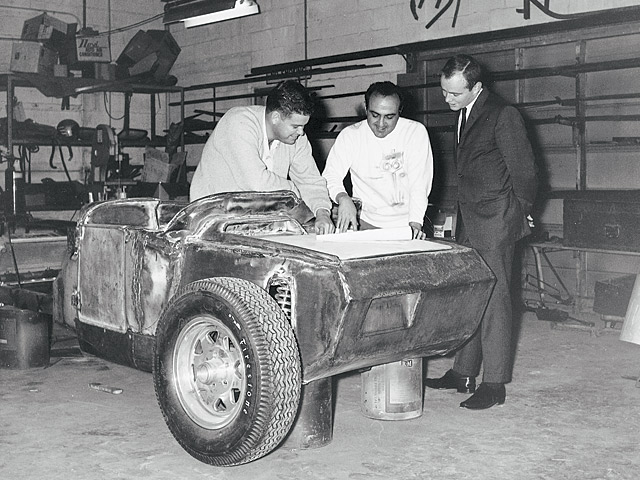
http://www.hotrod.com/articles/0302sr-xr6-hot-rod-project-car/

There isn’t much aftermarket equipment on the XR-6, because nothing much existed in the early-’60s. As to that name, Bob Greene asked me how come I called it that. “Well, it is an experimental roadster, with six-cylinder power.” At the time we didn’t think much about the project, only that we wanted to get rodders excited about designing and building cars a bit more in the then-modern trend. It is often said now that this car was the first of the hot rodding concept machines we see so commonly today. I guess that’s true. The car went on to win a lot of awards, and it is now something of a collector’s item in the model car world. Whatever, I sold the car to Joe Kizis (with trailer) for $3,600! Yes, it was a virtual steal. Joe used it as the feature of his Hartford (Connecticut) Autorama for a couple years. I lost track of it for a longtime then I got a call from a fellow working at Juliano’s Interior Products in Vernon, Connecticut. Turned out he had seen the car in an alley garage. Shortly thereafter, I met the owner, who was competing in the Great American Race. I was doing PR out of Dallas for that race, and it seems the XR-6 owner liked to restore circle track cars. For some reason, he knew of the car, and had bought it from a museum that Kizis had sold the car to many years past. He said he would get it out on rare occasions just to keep it limbered up.

The XR-6 only shows about 300 miles on the odometer, but I drove it for a couple of hundred before hooking up the speedo. Doesn’t matter, it’s a good handling and spirited ride. It’s really a good leader in design, but construction was not anywhere near what is being built today. But, you gotta start somewhere, and it really did serve to shape the future of hot rodding.(Editor’s Note: STREET RODDER would like to thank Bob Juliano of Juliano’s Interior Products for arranging with the Barlow family, the current owners of the XR-6, to have Ed Kania photograph one of our hobby’s true trendsetters and a most beautiful roadster! B.B.)

http://www.hotrod.com/articles/0302sr-xr6-hot-rod-project-car/
_________________
We don't care the People Says , Rock 'n' roll is here to stay - Danny & the Juniors - 1958
 XR6 Experimental Roadster
XR6 Experimental Roadster

Original year: 1963
Company: AMT
Scale: 1/25
Designer: Steve Swaja
The XR-6 represents a bold step forward in the field of hot rodding. LeRoi "Tex" Smith of the Hot Rod Magazine staff, in his collaboration with a dedicated group of automotive specialists, has produced an updated version of the classic "street rod". No mere display curiosity, XR-6 is completely drivable and features independent suspension, a full-race Weber-carbureted Lancer slant six engine under its sleek hood, and a fully instrumented and finely detailed cockpit. Working around a '27 Ford "T" roadster body, talented designed Steve Swaja evolved the ground-hugging body which retains the lean, function feel of transitional street roadsters. On its first public showing, the XR-6 began what promises to be a long and successful automotive life by winning the Oakland National Roadster Show's award, "World's Most Beautiful Roadster!"
http://www.showrods.com/showrod_pages/xr6.html
_________________
We don't care the People Says , Rock 'n' roll is here to stay - Danny & the Juniors - 1958
 Re: Tex Smith’s Hot Rod XR-6
Re: Tex Smith’s Hot Rod XR-6
_________________
We don't care the People Says , Rock 'n' roll is here to stay - Danny & the Juniors - 1958
 Re: Tex Smith’s Hot Rod XR-6
Re: Tex Smith’s Hot Rod XR-6
_________________
We don't care the People Says , Rock 'n' roll is here to stay - Danny & the Juniors - 1958
 Re: Tex Smith’s Hot Rod XR-6
Re: Tex Smith’s Hot Rod XR-6
_________________
We don't care the People Says , Rock 'n' roll is here to stay - Danny & the Juniors - 1958
 Re: Tex Smith’s Hot Rod XR-6
Re: Tex Smith’s Hot Rod XR-6
_________________
We don't care the People Says , Rock 'n' roll is here to stay - Danny & the Juniors - 1958
 Re: Tex Smith’s Hot Rod XR-6
Re: Tex Smith’s Hot Rod XR-6
_________________
We don't care the People Says , Rock 'n' roll is here to stay - Danny & the Juniors - 1958
 Re: Tex Smith’s Hot Rod XR-6
Re: Tex Smith’s Hot Rod XR-6
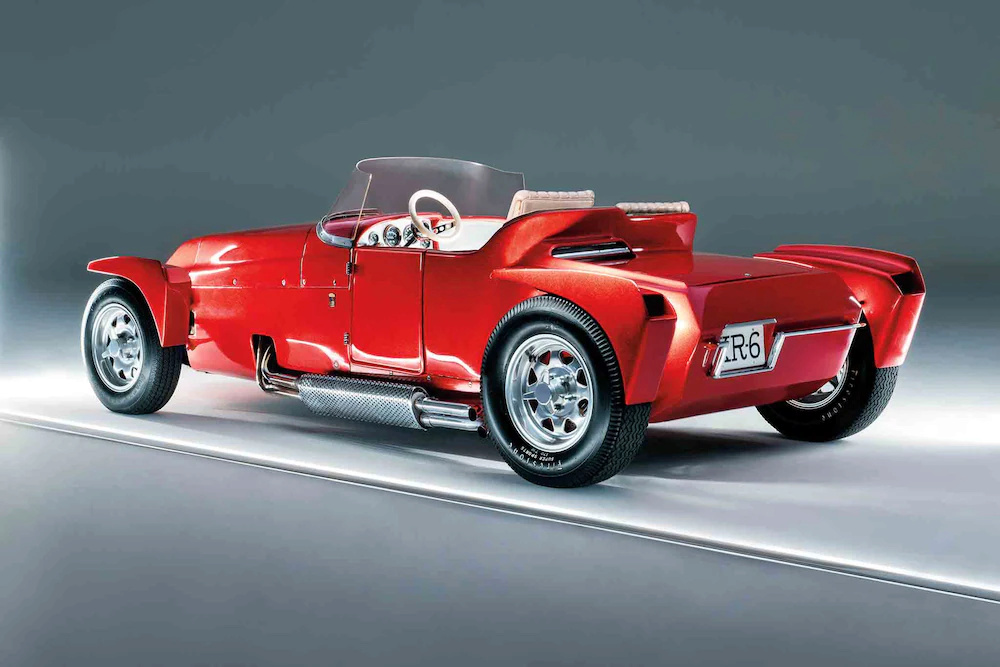
The XR-6 Roadster looks like a full-scale car from a vintage amusement park kiddie ride, and The Reactor seems every bit the Hollywood star car it would eventually become. More than that, they represent the vision of their creators, former Hot Rod editor LeRoi "Tex" Smith and legendary car customizer Gene Winfield. Each car was born in the misty haze of imagination, transformed into real metal and rubber and Plexiglas, belching sooty exhaust as they go.
"These were individuals who had an idea that they wanted to bring to fruition, and we're celebrating that," Gross says. "We're celebrating automotive ingenuity and innovation in that era. Even though all these designers dreamed the same dream, these people were all substantially different from each other."
https://www.motortrend.com/features/two-one-off-socal-customs-set-invade-pebble-beach-concours
Dernière édition par Predicta le Ven 8 Oct - 23:00, édité 1 fois
_________________
We don't care the People Says , Rock 'n' roll is here to stay - Danny & the Juniors - 1958
 Re: Tex Smith’s Hot Rod XR-6
Re: Tex Smith’s Hot Rod XR-6
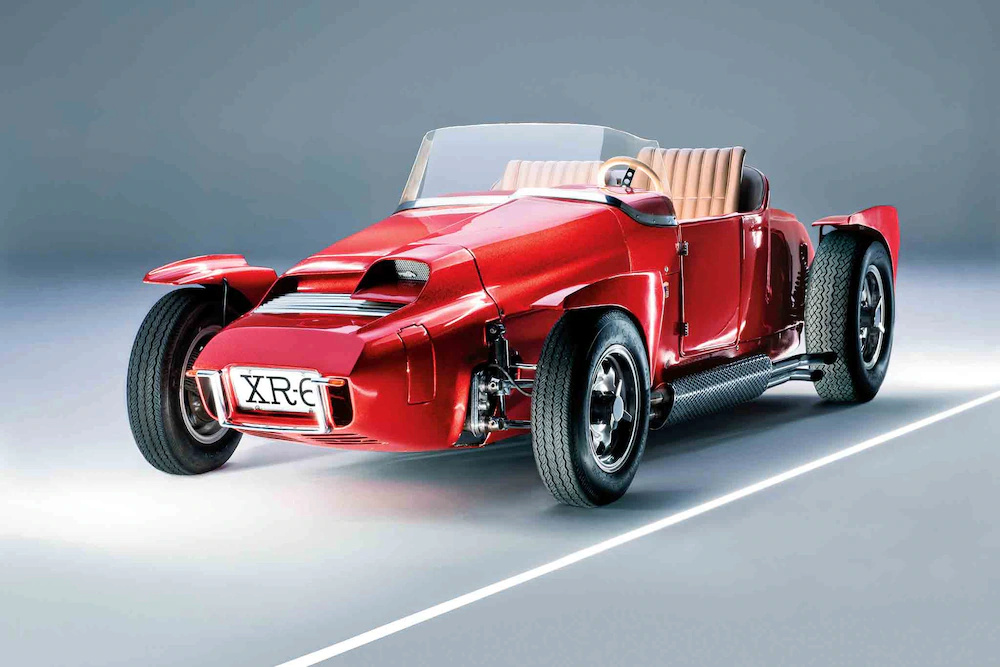
Take the late LeRoi "Tex" Smith, for example. Born in Oklahoma in 1934 but raised for a time in Texas, Smith was an Air Force fighter pilot before settling into California's burgeoning hot-rod scene and taking a job as associate editor of Hot Rod magazine in 1957. It was there where Smith, by 1961, began mulling the hot rod's relevance in an era of ever-increasing performance from new, showroom stock cars. The XR-6 was born from this line of thinking, with the name meaning X-perimental Roadster 6-cylinders.
"The XR-6 became the cover car for Hot Rod magazine," Gross recalls. "Tex was trying to say, 'This is the hot rod of the future. '"
The project started in Smith's home garage, where he welded up a steel ladder frame and dug out an engine—a hopped-up, aluminum-block Chrysler slant-six that came from a warmed-over Dodge press tester. The slant-six was unusual for its six cylinders canted at a 30-degree angle to achieve a lower profile (allowing a lower hoodline) and improve efficiency of exhaust flow. Its unique design also became part and parcel of the XR-6's asymmetric hoodline—taller on one side than the other. Volkswagen torsion-bar suspension and Triumph disc brakes were fitted up front, while coilover shocks—a rarity at the time and inspired by Indy-car design, custom-made for the project by Monroe—were fitted to the rear, along with trailing links and a Panhard bar.
Dernière édition par Predicta le Ven 8 Oct - 23:01, édité 1 fois
_________________
We don't care the People Says , Rock 'n' roll is here to stay - Danny & the Juniors - 1958
 Re: Tex Smith’s Hot Rod XR-6
Re: Tex Smith’s Hot Rod XR-6

Styling duties went to Steve Swaja, then a student at nearby ArtCenter College of Design, who sketched out a body with a front similar to an open-wheel race car and a rear that was a composite of a 1923 and '27 Ford Model T body. A timely infusion of cash from scale-model builder AMT—the company wanted this new hot rod to be the basis for a model kit—took the styling to an even wilder level.
"Certain things, like having a six-cylinder engine, isn't exactly a hot-rod-type thing," Gross says. "But the car itself was a period piece and in its time represented a big step away from '32 Fords and so forth. It made a big splash in its day."
Smith wanted to have the body made of aluminum and found a builder, but AMT had a contract with ace customizer George Barris and mandated the work be done at his shop. The XR-6 was slated to debut at the 1963 Grand National Roadster Show in Oakland, California, but when Smith informed the organizers it might not be ready in time, he was told it had to be ready: The XR-6 had already won the show's America's Most Beautiful Roadster (AMBR) award.
Dernière édition par Predicta le Ven 8 Oct - 23:01, édité 1 fois
_________________
We don't care the People Says , Rock 'n' roll is here to stay - Danny & the Juniors - 1958
 Re: Tex Smith’s Hot Rod XR-6
Re: Tex Smith’s Hot Rod XR-6

The car was displayed in Oakland that year. Also at the show, Smith ran into California-based customizer Gene Winfield whom he would hire to remake the XR-6's aluminum fenders, hood, and nose. Barris' crew had struggled with the job and used plenty of heavy lead filler. The completed XR-6 graced the cover of Hot Rod's August 1963 issue.
The XR-6 is now a proud part of the Petersen Automotive Museum's collection in Los Angeles, after its purchase in 2006 by the late Robert Petersen, founder of both the museum and Hot Rod magazine. Leslie Kendall, the Petersen Museum's chief curator, explains the XR-6's place in automotive history.
"I think [Smith] was trying to show that a hot rod could be civilized and styled right for modern times," Kendall says. "It's as nontraditional a hot rod as you can possibly find. It doesn't resemble any other vehicle and is very much a product of its time."
Dernière édition par Predicta le Ven 8 Oct - 23:02, édité 1 fois
_________________
We don't care the People Says , Rock 'n' roll is here to stay - Danny & the Juniors - 1958
 Re: Tex Smith’s Hot Rod XR-6
Re: Tex Smith’s Hot Rod XR-6
_________________
We don't care the People Says , Rock 'n' roll is here to stay - Danny & the Juniors - 1958
 Sujets similaires
Sujets similaires» Warren Smith
» Huey"Piano"Smith
» Chevy Pick up 1947 - 1954 custom & mild custom
» The Liberace - 1932 Ford Roadster - Craig Smith
» Ford 1957 & 1958 custom & mild custom
» Huey"Piano"Smith
» Chevy Pick up 1947 - 1954 custom & mild custom
» The Liberace - 1932 Ford Roadster - Craig Smith
» Ford 1957 & 1958 custom & mild custom
Permission de ce forum:
Vous ne pouvez pas répondre aux sujets dans ce forum
 Connexion
Connexion






